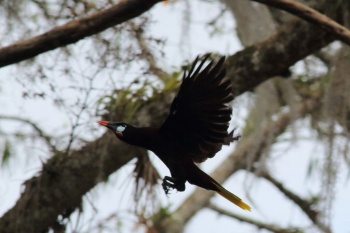(All sections expanded. Flight picture. References started.) |
(→External Links: New combined GSearch. GSearch checked template) |
||
| Line 32: | Line 32: | ||
{{ref}} | {{ref}} | ||
==External Links== | ==External Links== | ||
| − | {{GSearch| | + | {{GSearch|"Psarocolius montezuma" {{!}} "Gymnostinops montezuma" {{!}} "Montezuma Oropendola"}} |
| + | {{GS-checked}}1 | ||
| + | <br /> | ||
| + | <br /> | ||
[[Category:Birds]] [[Category:Psarocolius]] | [[Category:Birds]] [[Category:Psarocolius]] | ||
Latest revision as of 21:12, 28 January 2023
- Psarocolius montezuma
Identification
Male 39.5-47.5 cm (15½-18¾ in);
female 34.7-39.8 cm (13¾-15¾ in)
- Black head, nape, upper back and throat
- Chestnut upperparts
- Yellow outer rectrices
- Blackish central rectrices
- Blue bare facial skin
- Pinkish wattle under chin
- Red or orange tip to black bill
Distribution
Central America: found from Gulf-Caribbean lowlands of south-eastern Mexico, through Guatemala, Belize, Honduras, Nicaragua and Costa Rica, to central Panama
Taxonomy
This is a monotypic species[1]. It is sometimes listed as belonging in genus Gymnostinops .
Habitat
Forest canopy, edges and old plantations.
Behaviour
Diet
Their diet consists mostly of arthropods and small vertebrates. They also eat fruit, seeds, and nectar.
Breeding
They nest in colonies using tall trees. The nest, constructed by the female, is a long pouch attached to a branch; it is lined with leaves. It is thought there two white or buffy eggs are laid, but usually only one chick is raised. Incubation takes about 15 days, with the young fledging after a further 29-42 dats,
References
- Clements, J. F., T. S. Schulenberg, M. J. Iliff, S. M. Billerman, T. A. Fredericks, B. L. Sullivan, and C. L. Wood. 2019. The eBird/Clements Checklist of Birds of the World: v2019. Downloaded from http://www.birds.cornell.edu/clementschecklist/download/
- Avibase
- Sample, R. and R. Kannan (2020). Montezuma Oropendola (Psarocolius montezuma), version 1.0. In Birds of the World (T. S. Schulenberg, Editor). Cornell Lab of Ornithology, Ithaca, NY, USA. https://doi.org/10.2173/bow.monoro1.01
Recommended Citation
- BirdForum Opus contributors. (2024) Montezuma Oropendola. In: BirdForum, the forum for wild birds and birding. Retrieved 23 April 2024 from https://www.birdforum.net/opus/Montezuma_Oropendola
External Links
GSearch checked for 2020 platform.1






